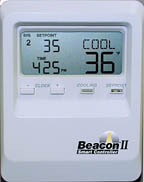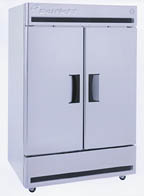“The number-one factor contributing to food-borne illness is improper cooling of food,” dietician Mary Anne Houge told attendees during a seminar held in the midst of the exhibit hall where 625 exhibitors were showing their wares. It was her contention that only blast freezers cool food down quickly enough through the “danger zone” of 140? to 41?F.
“The longer high-risk food is at the danger zone temperatures, the more chances bacteria have to multiply to levels that cause food poisoning,” she said. “And you cannot get food through the danger zone 100% of the time without a blast chiller.”
Houge is vice president of food safety services for the Steritech Group of Charlotte, NC, an organization that has no ties to industry manufacturers. Yet she encouraged attendees to visit booths of blast chiller makers.
“Run, don’t walk, to those vendors and get their information,” she said. “The blast chiller should be a standard piece of equipment in kitchens.”
Some 21 companies at the show had information on such chillers, including such familiar names to the hvacr industry as Alto-Shaam, Bally, Delfield, Elliott-Williams, Enodis, Hobart, and Victory.

Blast Chillers
An example of the technology included, from Victory (Cherry Hill, NJ), roll-in units capable of chilling 175 to 600 lb of food in a 90-minute cycle. One aspect is what the company called a “1, 2, 3” control panel. The first step moves the unit from the normal storage mode of 38?F into the blast chill mode. The second step allows hard chill or soft chill, the first circulating colder air suitable for most applications and the second to keep the air circulating above 32? for more delicate food products. The third step terminates chilling based on one of four preset times.Delfield (Mt. Pleasant, MI) also showed a line of blast chillers. A highlighted unit was the DBC-10, a 100-lb unit with four modes of operation and four temperature probes. The design is said to allow the operator to use it as two separate 50-lb units if needed.

Ice Machines
In the ice machine sector, a common ice-making technology in Europe involving a rotating evaporator made its debut with a U.S.-based company, Scotsman (Vernon Hills, IL), which showed such a method in an industrial flake ice machine. Rather than submerge the evaporator in water as is common overseas, the Scotsman method skims the water bath and has an auxiliary water spray to maximize ice production. A stationary stainless steel blade constantly removes the ice. Units are said to produce from 1,400 to 2,200 lb of ice per day.IMI Cornelius (Anoka, MN) showed ice-making machines called Xtreme Ice™. According to Rick Brua, vice president for independent distribution, the units “have the lowest cost per 100 lb of ice production, the most consistent ice harvest in the industry (the technology with a patent pending), and interchangeable front panel graphics.”
Ice-O-Matic (Denver, CO) announced the exclusive commercialization using AglON™ anti-microbial in its cube icemakers. The compound is said to control the growth of odor-causing bacteria, mold, and mildew on the equipment.
Follet (Easton, PA) pointed to its ice dispensers’ European styling, compact design, and zero-side clearance. The company touted the product as “music to your ears” and identified it as the Symphony Series.
SerVend (Sellersburg, IN) offered the aftermarket a cold carbonation retrofit kit said to bring higher carbonation levels and consistent water temperatures.
Manitowoc (Manitowoc, WI) featured the Guardian System, a small component mounted on top of an ice machine. It releases chlorine dioxide on a controlled basis to inhibit the growth of bacteria and fungi that could form slime and cause odors in the food zone of an ice machine. Manitowoc and Ecolab developed the component. Also new at Manitowoc was the Series 600C remote ice cube machine designed specifically for beverage dispensers.
Kold Draft (Erie, PA) showed an icemaker that produces both cubes and crushed ice with side-by-side bins for storage of each type of ice.
Howe (Chicago, IL) extended its product line to include its RapidFreeze® Model 1000 commercial-sized icemaker capable of producing about 1,000 lb of ice in 24 hrs. The previous smallest unit from the company was a 2,000-lb production model.
Vogt (Louisville, KY) showed industrial ice machines that the company said were “economical and uncomplicated.”
Refrigerators, Coolers, And Freezers
Hoshizaki America Inc. (Peachtree City, GA) drew attention to its HNC Series of countertop refrigerated display cases. Among technological touches were a large-diameter upper evaporator with tin plating, condenser airflow in the back and out the side, and a larger condenser face area to improve cooling performance.Summit (Bronx, NY) showed a refrigerator that offers no-frost technology in an undercounter size.
Coolers from Koolco (Hialeah, FL) were said to come preassembled with a flush-mounted, dial- type thermometer, color coded to display the proper operating temperature range.
CrownTonka (Commerce, CA) promoted its Thermalrite line of walk-in coolers and freezers that it said used a minimum of cam-locks yet still provided a tight seal.
Walk-in refrigeration from Thermo-Kool (Laurel, MS) featured an all-urethane design with high-density structure for strength and rigidity.
U.S. Coolers (Quincy, IL) showed walk-ins with modular construction and tongue-and-groove edges to allow ease of installation.
NorLake (Hudson, WI) also showed a range of custom-formulated coolers and freezers.
McCall (Franklin, TN) showed a freezer that can hold food at –10?F. According to the company, “This type of cabinet, often used as an ice cream freezer, holds colder temperatures than a standard freezer, thus enabling foods to be stored and remain fresher for a longer period of time.”
Beverage Air (Spartanburg, SC) showed a range of products including a number of new reach-ins.
Controls
Master-Bilt (New Albany, MS) featured electronic controller boards and a master controller for walk-ins. The controller board is said to replace such standard mechanical parts as a room thermostat, defrost timer, defrost termination/fan delay control, and temperature indicator. Service is said to be easier due to the reduced number of parts. The master controller is part of the company’s refrigeration system that also contains condensing unit, evaporator, electronic expansion valve, and temperature sensors.Heatcraft (Stone Mountain, GA) talked about the Beacon II refrigeration system that has a user interface to allow the user to control multiple systems from a single location.
Elreha (St. Petersburg, FL) showed several cold storage controllers for use with electronic expansion valves and with auto-adaptive defrost functions.
Components And Curtains
Heatcraft reported that it had expanded its PRO3 refrigeration systems to encompass mechanicals for coolers ranging from 2,500 to 14,500 Btuh and freezers ranging from 1,850 to 9,050 Btuh. Units are mounted on top of coolers or freezers.Hussmann (Suwanee, GA) promoted its Protocol line of refrigeration equipment, which allows the positioning of smaller mechanical units in several locations within a facility to reduce refrigerant lines and thus the amount of refrigerant needed.
Cold Zone (Brea, CA) had water-cooled and air-cooled refrigeration systems.
RDI (Parsons, TN) announced an expansion of its product line of condensing units.
Cooper Instruments (Mid-dlefield, CT) used the show to announce the release of a CD-ROM catalog of its full-line printed catalog. It also showed a mini datalogger to track temperatures of perishable products.
Raytek (Santa Cruz, CA) showed the MiniTemp FS, which measures food surfaces in the critical temperature zone.
Weiss (Holtsville, NY) showed a 2-in. round LED thermometers configured to avoid problems encountered with transformers.
Aleco (Tuscumbia, AL) featured an air curtain with stainless steel casings, centrifugal fans, raised inlet screens, discharge nozzle, and a 1/4-hp motor.
Berner (New Castle, PA) featured the Zepher Air Door, which, at 7 1/4 ft high, was said to work well in low-clearance applications. It has a solid state, variable-speed control switch.
Mars (Gardena, CA) had air curtains that were promoted as a means to curb airborne bacteria at the entrance to a building.
Bally (Morehead City, NC) showed a concept called Adapt-A-Door, which offers three types of doors, including cooler/freezer door that the company said can be adapted to almost any retrofit or replacement situation.

Sidebar: Energy Efficiency Push More Than Just A Sales Pitch
ORLANDO, FL — A recurring theme at the NAFEM show was equipment efficiency. It was more than a sales pitch. It is being backed more and more by governmental regulations.“Energy conservation in refrigeration is currently being pursued on numerous fronts,” according to a statement issued at the conference by officials of the Mt. Pleasant, MI, company Delfield, which makes a wide range of food service equipment.
“The EPA will soon announce a program to encourage manufacturers to label energy-efficient products. Consumers may receive discounts from local utilities for purchasing or using these products.”
The release went on to note that California had enacted strict regulations for energy use by refrigerators that take effect in July 2002. “Other states are expected to follow suit,” the company said.
Further, the Delfield officials said that manufacturers were starting to make the same energy-efficiency effort in the commercial sector that they have been making in the residential market.
Delfield contended that its Vantage 6000 Series “represents one of the first times those efforts have been applied to the commercial field.”
In a related announcement, Fort Worth, TX-based Traulsen reported that “a reputable third party has tested our Model G20010, two-section refrigerator, and found that it beats the state of California energy standards proposed to go into effect in 2002 by 36% and the tougher proposed 2004 standard by 33%.”

Sidebar: Strange Ice Slab Draws Curious Onlookers
ORLANDO, FL — The monolithic piece of granite caught the curious glance of almost every person that neared it. A thin layer of ice had formed on the surface.Some brave souls cautiously reached out to touch the strange object. When one man raised a camera to photograph it, he was rebuffed by a guardian of the object — until the guardian was told the picture was for a refrigeration trade publication.
The eye-catching display was at the booth of Refcon of West Haverstraw, NY, at the most recent NAFEM show.
“We create a frost top surface and how we do it is part of our secret,” said the guardian/booth official. The entire assembly is 7 in. thick and up to 12 ft long, mounted on two stainless steel bases, one of which holds the mechanical refrigeration equipment. It is used for product displays like fruits, desserts, and seafood.
“A refrigeration mechanic should be able to service this,” said the official. “There are standard refrigeration controls.”
The ice buildup results from the mechanical refrigeration and moisture in the air. In dry ambients, a spray bottle helps create the moisture.
Publication date: 12/03/2001


Report Abusive Comment